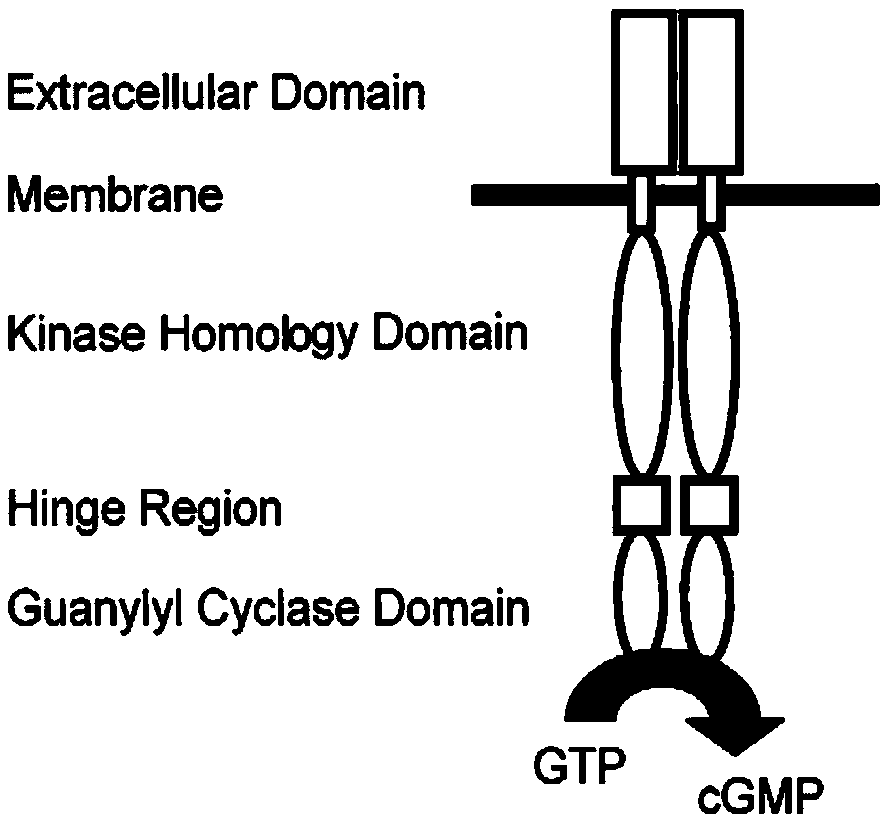Anti-GCC nucleic acid, preparation method thereof, immune cell having the nucleic acid, and application thereof
An immune cell and nucleic acid technology, applied in the field of genes, can solve the problems of less than 50% survival rate, recurrence and distant metastasis of colorectal cancer patients, and achieve the effect of improving clinical effectiveness.
- Summary
- Abstract
- Description
- Claims
- Application Information
AI Technical Summary
Problems solved by technology
Method used
Image
Examples
Embodiment 1
[0049] Anti-GCC nucleic acid comprising at least a Leader nucleotide sequence, a GCC single-chain antibody nucleic acid artificial sequence, a CD8 hinge region nucleotide sequence, a transmembrane-stimulatory domain nucleotide sequence, and a CD3ζ signaling region nucleotide sequence , the self-cleaving peptide T2A nucleotide sequence, the chemokine IL7 nucleotide sequence and the chemokine CCL19 nucleotide sequence. Wherein, the transmembrane-stimulatory domain nucleotide sequence is selected from CD8, CD27, CD28, CD137 (ie 4-1BB), CD134 (ie OX40), all or part of DNA fragments of ICOS molecules.
[0050] In this embodiment, the nucleic acid of described anti-GCC, it comprises CD8 Leader nucleic acid artificial sequence (SEQ ID NO.2), GCC single-chain antibody nucleic acid artificial sequence (SEQ ID NO. 3), CD8 hinge region nucleic acid artificial sequence (SEQ ID NO. 4), CD8 transmembrane region nucleic acid artificial sequence (SEQ ID NO. 5), 4-1BB costimulatory region nucl...
Embodiment 2
[0052] The preparation method of the nucleic acid for the treatment of GCC, comprises the steps:
[0053] (1) According to the artificial sequence of Leader nucleic acid, artificial nucleic acid sequence of GCC single-chain antibody, artificial nucleic acid sequence of CD8 hinge region, artificial nucleic acid sequence of CD8 transmembrane region, artificial nucleic acid sequence of 4-1BB costimulatory region, artificial nucleic acid sequence of CD3ζ signaling region , Synthesize the entire expression frame of the self-cleaving peptide T2A nucleic acid artificial sequence, the IL7 nucleic acid artificial sequence, the self-cleaving peptide T2A nucleic acid artificial sequence, and the CCL19 nucleic acid artificial sequence and insert it into the standard vector pUC to obtain pUC-GCC-CAR;
[0054] (2) Double-enzyme digestion of pUC-GCC-CAR, cut off the agar part of the GCC-CAR DNA fragment by agarose gel electrophoresis, treated with DNA extraction kit sol solution, passed throu...
Embodiment 3
[0059] The plasmid containing the gene described in Example 2, the plasmid is a plasmid obtained by inserting the fusion gene fragment GCC-CAR DNA into the lentiviral expression vector pLent-C-GFP, named 7×19pLent-GCC-CAR. The plasmid was prepared by the following preparation method: the above-purified GCC-CAR DNA fragment and the linearized pLent-C-GFP DNA fragment were ligated in the following system: 10×buffer: 1 μl; T4 ligase: 1 μl; GCC-CAR DNA fragment: 4 μl; linearized pLent-C-GFP DNA fragment: 4 μl, formed by ligation.
[0060] In the present embodiment, this plasmid is prepared by the following method:
[0061] According to the artificial sequence of Leader nucleic acid, artificial nucleic acid sequence of GCC single chain antibody, artificial nucleic acid sequence of CD8 hinge region, artificial nucleic acid sequence of CD8 transmembrane region, artificial nucleic acid sequence of 4-1BB costimulatory region, artificial nucleic acid sequence of CD3ζ signal transduction...
PUM
| Property | Measurement | Unit |
|---|---|---|
| Titer | aaaaa | aaaaa |
Abstract
Description
Claims
Application Information
 Login to View More
Login to View More - Generate Ideas
- Intellectual Property
- Life Sciences
- Materials
- Tech Scout
- Unparalleled Data Quality
- Higher Quality Content
- 60% Fewer Hallucinations
Browse by: Latest US Patents, China's latest patents, Technical Efficacy Thesaurus, Application Domain, Technology Topic, Popular Technical Reports.
© 2025 PatSnap. All rights reserved.Legal|Privacy policy|Modern Slavery Act Transparency Statement|Sitemap|About US| Contact US: help@patsnap.com



